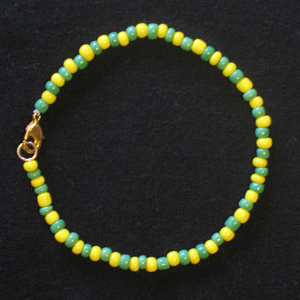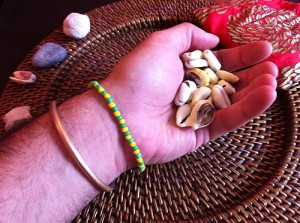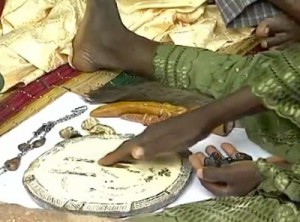Does your spiritual lineage work with Ifá or is it an Ocha house? (Ocha is a Spanish contraction of Orisha) This is a common question you’ll hear among santeros and it is a topic of great debate. There seem to be two major ways of working the religion of Santeria: spiritual lineages who work with Ifá and Babalawos, and those who don’t. Both are legitimate and valid practices but what is the difference, and why does this disparity exist in Santeria?
What is Ifá and Who are Babalawos
Ifá is the name of the sect of Orunmila within Santeria. Orunmila (also spelled Orunla or Orula) is the orisha of divination who knows how our fate will unfold. Some practitioners also call Orunmila by the name Ifá. The reason I specifically call out Ifá as a separate sect is because the ritual functions within the Ifá sect can only be accomplished by priests of Orunmila – called Babalawos (or Oluwos if they were orisha priests prior to passing to Ifá – which many are). Only Babalawos can give the Eshu that is received in Ifá. Only Babalawos can give the Idé of Orunmila (bracelet of Orunmila), which is always worn and keeps the spirit of Ikú (death) at bay. Only Babalawos can divine with the okuelé (diviner’s chain) and the ikín (palm nuts) – and these are the ONLY divination tools used in Ifá. Only Babalawos can give Kofá or Awofakán (Mano de Orula), giving a smaller shrine of Orunmila for people to have in their home (note this is not a consecration as a priest of Orunmila – it is a reception of his mysteries into your life for balance and to learn one’s destiny). Only Babalawos can consecrate other Babalawos as priests. A Santero or Santera cannot do these things.
But the inverse is also true. A Babalawo cannot do many of the things a Santero or Santera can. They cannot give addimú orishas (token Orishas) to others except for the Warriors (Eshu, Ogun, Ochosi, Osun), Osain, Olokun and Oduduwa – and even then they can only give the Ifá style ones that can never be passed on by that individual (unless they become a Babalawo in time). They do not read diloggún (cowrie shells) – they stick only to the use of the diviner’s chain and palm nuts. There is a pataki (legend) that Orunmila surrendered the cowries to Oshun and the orishas to use after she mastered the skill simply by watching him – and he swore that he would create a new system only for men, and only for his priests; that was the okuelé and ikin. Babalawos cannot give the initiation of Elekes (necklaces) – but they can give Orunmila’s eleke to people. They cannot initiate people in the Kariocha ceremony to be priests of other Orishas. They can perform sacrificial rights, or entrance readings leading in to a kariocha but they cannot be in the sacred room when the initiation is taking place. They do not birth orishas.
So in many ways, the Ifá sect is a subdivision of Santería. A cloistered sect of diviners with membership limited to heterosexual men, who dedicate their lives to the mastery of divination, the science of Ifá and the knowledge of Odu. Babalawos are not the high priests of our religion. That is a misnomer perpetuated in many of the early books on Santeria written by outsiders to our faith. They are the masterful diviners in our religion who focus solely on the function of Ifá.
Lineages that Work with Ifá
Many of the spiritual lineages, or “houses”, that work with Ifá will regularly go to Babalawos or include them in their ritual functions. Babalawos are consulted when determining the tutelary Orisha of an individual. In this ritual, three Babalawos (minimum) gather together and use the ikin (palm nuts) and the Opón Ifá (table of Ifá) to determine that person’s tutelary Orisha. This is often done when a person received their Kofá or Awofakán (mano de Orula, hand of Orunmila). Ifá believes that only a Babalawo can determine a person’s tutelary Orisha because Orunmila witnessed destiny unfold. (Orisha priests will argue this point and explain that it was Orunmila and Elegguá who witnessed fate together and that Elegguá actually preceded Orunmila, so Elegguá can also tell us who a person’s tutelary orisha is.) Houses that work with Ifá will also employ Babalawos to perform sacrificial rites during ceremonies, and they will have Babalawos perform the entrance reading and the Ebó Até (cleansing at the mat) during a person’s life reading.
A person becomes a Babalawo when they are told they have a destiny in the sect of Ifá through divination. This can be through the life reading when receiving Awofakán, or it can be through a life reading received after their Kariocha. Not everyone can become a Babalawo. Women and gay men are strictly prohibited from being initiated as Babalawos in Santería Lucumi (Lukumí). Some individuals go from being an Aborisha directly into the sect of Ifá as a priest of Orunmila. Most others end up being initiated as an Olorisha to their tutelary orisha (Elegguá, Ogún, Oshun, Yemaya, etc.) and then later in life “pass to Ifá” and become ordained as a priest of Orunmila (Babalawo). These individuals are called Oluwos (Oluos). The moment they pass to Ifá they no longer function as an Olorisha and can no longer participate in the rituals that an Olorisha officiates (elekes, warriors of ocha, kariocha, etc.). They dedicate their lives to the sect of Ifá and the ritual functions to which they are limited.
Lineages that Do Not Work with Ifá
Many spiritual lineages, or “houses”, do not work with Ifá at all. In these houses the Obá Oriaté will officiate all ceremonies. The Oriaté is an orisha priest who has been specially consecrated due to his knowledge of divination and all of our ceremonial rituals, to officiate rituals in the sacred room (igbodú). Since the Oriaté is a Santero or Santera, he/she can do much more for an orisha initiate than a Babalawo can – but he cannot perform the special functions that are restricted to Ifá. An Oriate can determine the tutelary Orisha of an individual (actually any orisha priest can, provided he or she is a skilled diviner). This is performed either using the cowrie shells of the godparent’s tutelary orisha, or with the diloggun of Eleggua (because Elegguá witnessed all destiny and knows everything taking place – and is truly neutral). Houses that do not work with Ifá argue that Olorishas are the only ones who should truly determine a person’s tutelary orisha because they actually birth orishas and crown people as priests, where Ifá does not. (Personally I do not think this is a determining factor because you can cite the impartiality of Ifá as an equally valid reason to let Babalawos do this.) In non-Ifá houses, the Oriaté performs sacrificial rites (so can any individual who has received Pinaldo – the sacred knife), the Oriaté does the entrance readings prior to Kariocha and the Ebó Até (cleansing at the mat) during a person’s life reading. The Oriaté officiates the kariocha ceremony where a priest is initiated. Oriatés can birth and give addimú orishas (token orishas) or any other function in the religion. They are the Orisha High Priests.
Why the Division? Where Did This Originate?
The separation between Ifá and Ocha lineages has historical roots. When the slave trade of the Yoruba began, the spiritual practices of the Yoruban tribes were just starting to solidify into one religion. As millions of Yoruba people, especially Olorishas, were sold into slavery, the Yoruba populace was divided by the vast expanse of the Atlantic Ocean. The religion continued to evolve back in Africa, and evolved differently here in the Americas. This accounts for this disparity between the two religions and explains why Yoruba Traditional Religion has commonalities with, but cannot be compared directly to Lucumi/Lukumí Religion. The followers of Ifá in Africa were relatively untouched by the slave trade, and the sect of Ifá in Africa grew in prominence and ritual function. In Traditional Yoruba Religion, Ifá is deeply intertwined with Orisha worship and plays a different role than in Lukumí. The followers of Ifá, as a population, were the last group taken in slavery and brought to Cuba.
In Cuba, as Santeria Lucumi started to take form, there was a marked absence of Babalawos and the Ifá sect. The style of initiation performed in the Yoruba city of Oyo became the most prominent style of initiation in Santeria. This initiation includes the reception of the “four pillar” orishas of Santeria regardless of that person’s tutelary orisha: Obatala, Oshun, Yemaya and Chango. The Obá Oriaté functioned as the master of ceremonies in all rituals. Women were the strongest leaders in Santeria and every lineage will honor mighty women in their Moyuba prayer. Santeria Lucumi unified in practice and purpose in the late 1800’s. There is historical evidence that by 1860, Lucumi people were performing ordinations to priesthood. Santeria, without the influence of Ifá, was functioning strongly in Cuba up until the early 1900’s.

The Idé of Orunmila can be worn by anyone to protect them from Ikú (death) but only Babalawos and Oluwos can give the bracelet and confer this protection
In the early 1900’s, women who were once the strongest and most powerful leaders in Santeria, began losing prominence as the Babalawos and sect of Ifá rose in power. In the sect of Ifá, when a Babalawo marries a woman Olorisha, she becomes an Apetebí Aya Ifá (slave of Ifá) and is forbidden from performing diloggun divination. Divination becomes the sole domain of the Babalawo in that house, and women are subjugated. Many of the most powerful women in Santeria were getting married to Babalawos because of the status associated with the position, but in the process, women lost power in Santeria. Babalawos became the master of ceremonies in those houses, and thus began the difference between spiritual lineages that work with Ifá versus those that are Ocha-centric. The office of Oriaté, once traditionally held by the most influential women in our religion, became dominated by men. To date there are two, perhaps three, female Oriatés left in the United States, and a few more in Cuba. In modern times, most Apetebís know very little about Ocha, and mainly defer to their husbands about knowledge of Ifá.
Therefore, the lineages that do work with Ifá typically introduced this sect into their Santeria practice through marriages in the past. A female Olorisha likely married a Babalawo and he began divining for everyone and running the show. Lineages that don’t have Ifá strongly involved in their practice likely never experienced this phenomenon. Both are traditional practices according to the culture bearers of the religion of Santeria.
Everyone Comes to the Feet of Ifá
In spite of the division between Ifá and Ocha-centric lineages, everyone will eventually come to Ifá for some need. Some go to Babalawos to get their Kofa or Awofakán (Mano de Orula, Hand of Orula) and that’s it. Others come for an occasional reading from time to time, or to receive the Idé of Orunmila (bracelet of Orunmila that keeps death at bay). Some will visit Babalawos when facing a very difficult spiritual obstacle to employ the tools of Ifá to break through it. While it is not required to participate with Ifá, at some point everyone will come to the foot of Ifá for assistance. For this reason alone, regardless of the divisions between us, we should all respect Orunmila and his special sect of diviners, the Babalawos.



 Pagan Blog Project
Pagan Blog Project
26 pings
Skip to comment form ↓